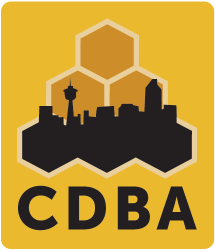Life cycle
Bumblebee colonies do not survive year-round. In the fall, they die off and the queens leave to hibernate elsewhere. Late October or early November is a good time to investigate the nest, and if it is in a house, seal off any entrances so that bees do not take up residence in the next year.
Bumblebees don’t cause any damage to homes. They do not eat wood (like wasps do), and don’t leave behind a big mess. If you can put up with living with the nest nearby, it should die naturally within a few months, and the bees will all leave or die at the end. If you don’t want bees nesting in the same place the following year, block up any entrances to the nest and other suitable nest spaces nearby. If the bees are being bothersome by entering and leaving the nest (e.g. in porches, where they usually fly at head height), you can try to obstruct their flight path or re-route the entrance of the nest using our advice, below.
Obstructing flight paths
Sometimes a bumblebee nest is under a porch or other hard to reach area and their flight path gets them in trouble with humans or pets. Consider using mats, cardboard, or plywood, to obstruct this path so that they fly in less objectionable spaces.
Re-routing bumblebee nest entrances
It is much easier to re-route bumblebee nest entrances to make the bees enter and leave in a different place than it is to move the nest entirely. This is especially useful if the entrance hole brings the bees into close proximity with people. To do this, get a length of flexible tubing that is at least 2cm in diameter. The type of tubing used in sink waste pipes works perfectly. Then, attach the tubing to the nest entrance. Make the junction between these as tight as possible, to avoid having bees coming out of the wrong place. Gaps can be plugged with soil. Then place the other end of the tube wherever you want the new entrance to be. Secure it in place as best you can, and place some ‘landmarks’ around it. The bees use landmarks to navigate, and whenever they leave the nest they will fly around the hole to memorise what features are around it. Anything can work as a landmark, but pebbles, plant pots, etc. all work well.
Moving bumblebee nests
We very much hope that people will only try to move nests that are in a particularly inconvenient locations. Underground nests will be difficult to move, as you’ll create a considerable amount of disturbance as you dig down to the nest. These nests can also have long tunnels that lead to the nest, so can be difficult to find.
If you do need to move a nest you will either need to do this yourself or get help from someone experienced in doing so. Please note that bumblebees can sting and are more likely to do so if their nest is disturbed. If you decide to move a nest, it is done at your own risk. Some honey bee-keepers will have some experience in moving bumblebee nests, but this is rare. Pest control companies often destroy the nests (although a few refuse to), so it’s best to avoid using their services for bumblebees unless absolutely necessary.
To move a nest safely it is best to do it in the dark – when all of the bees will be in the nest and docile. They might buzz a bit but they won’t fly in the dark, so it’s safest to do it then. They don’t see red light well, so if you need to see what you’re doing, put some red plastic film/acetate over a torch or use a red L.E.D. rear cycle light.
Safety
Bumblebees are less likely to sting than honeybees and wasps are. However, disturbing the nest can make them behave defensively, and precautions should be taken to prevent stings occurring. While a full bee-keepers’ suit is helpful, it is not necessary. As a minimum, a person moving a nest should wear full length rubber ‘washing up’ gloves, and a long-sleeved top, and cover any exposed skin as best they can.
It has also been found that bumblebees can become alerted to the presence of an intruder if they are breathed upon. Accordingly, it is best to try to avoid breathing on the nest.
Nests in other places
Bumblebees sometimes nest in places from which it is difficult to remove the nest without killing it. Porches, wall cavities, air vents, eaves and roof soffits have all been recorded. Because of the difficulty in reaching into these places, removing the nests from them cannot be done without help from someone experienced in moving bumblebees.
This information has been modified from the Bumblebee Trust Conservancy:

